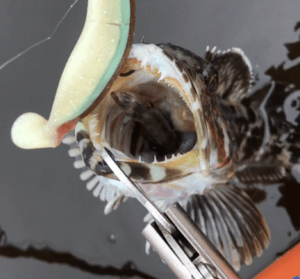Lingcod facts for kids
Quick facts for kids Lingcod |
|
|---|---|
 |
|
| Ophiodon elongatus | |
 |
|
| At Santa Catalina Island, California | |
| Scientific classification | |
| Kingdom: | |
| Phylum: | |
| Class: | |
| Order: | |
| Family: |
Hexagrammidae
|
| Genus: |
Ophiodon
Girard, 1854
|
| Species: |
O. elongatus
|
| Binomial name | |
| Ophiodon elongatus Girard, 1854
|
|
 |
|
| Range of the lingcod. | |
The lingcod (Ophiodon elongatus) is a cool fish that belongs to the greenling family. It's also sometimes called the buffalo cod or cultus cod. This fish is the only living member of its group, called Ophiodon.
Lingcod live along the west coast of North America. You can find them from the Shumagin Islands in Alaska all the way down to Baja California, Mexico. These fish can grow quite large! Some have been seen up to 152 centimeters (about 5 feet) long and weighing as much as 59 kilograms (about 130 pounds).
Lingcod come in different shades of gray and often have spots. They are a popular fish for people to catch and eat. Even though their name sounds like "ling" or "cod," they are not closely related to those fish. They just look a bit similar.
Did you know that about 20% of lingcod have blue-green or turquoise flesh? This unusual color disappears when the fish is cooked. Scientists think the color might come from a substance called biliverdin, but they are still studying it.
Contents
Where Lingcod Live and Grow
Lingcod are found only on the west coast of North America. Many of them live off the coast of British Columbia. They usually stay on the ocean bottom, often in rocky areas. You can find them in waters from 10 to 100 meters (about 33 to 328 feet) deep.
Studies show that lingcod don't travel very far. They tend to stay in the same local areas for most of their lives.
Lingcod Life Cycle
In October, lingcod start to move closer to shore to find places to lay their eggs. The male fish arrive first. They pick out nest spots in rocky cracks or ledges where the water current is strong.
Female lingcod lay their eggs between December and March. After laying their eggs, the females leave the nest right away. The male lingcod then guard the eggs very carefully. They protect the nest from other fish that might try to eat the eggs. This guarding continues until the eggs hatch, which happens from early March to late April.
When the eggs hatch, the tiny baby lingcod are called larvae. They float around in the open water until late May or early June. Then, they settle down to the bottom and become young fish, called juveniles.
Young lingcod first live in beds of eelgrass. Later, they move to flat, sandy areas. These aren't the usual places where older lingcod live. Eventually, they move to habitats that look more like where adult lingcod live, but they stay in shallower water for a few years.
How Lingcod Grow
Female lingcod become adults and can have babies when they are about three to five years old. At this age, they are usually 61 to 75 cm (about 24 to 30 inches) long. Male lingcod mature earlier, at about two years old, when they are around 45 cm (about 18 inches) long.
You can tell an adult male from a female by looking for a small, cone-shaped bump behind its anal fin. When they are very young (up to two years old), male and female lingcod grow at about the same speed. After two years, females start to grow faster than males. Males usually stop growing much bigger after about eight years old. Females, however, keep growing until they are about 12 to 14 years old.
Lingcod can live for about 36 years. They can reach a maximum size of around 150 cm (about 59 inches). Off the coast of Alaska, many lingcod can grow to be very heavy, sometimes reaching 70 pounds!
What Lingcod Eat
Lingcod are very hungry predators! They will eat almost anything they can fit into their mouths. This includes small sea creatures without backbones (invertebrates) and many different kinds of fish. Some of their favorite meals are herring, salmon, and Pacific hake. They also love to eat smaller octopuses and large rockfish.
Once lingcod survive their early stages as larvae, they don't have many predators themselves. Their main enemies are marine mammals like sea lions and harbor seals.
How Scientists Figure Out Lingcod Age
Scientists can figure out how old a lingcod is by looking at its fins. They use cross-sections (thin slices) from certain fin rays on the fish's second dorsal fin. This method works because, like tree rings, lingcod fins grow rings each year. These rings are called annuli.
To do this, scientists look at the fin slices under a microscope. They count the annuli to estimate the fish's age. It's important that the fins are dried flat and cut correctly. Sometimes, the very center of the fin ray in older fish can be missing. If this happens, scientists look at younger fish to learn how wide the first few rings usually are. This helps them guess where the missing rings would have been on older fish.
Images for kids







